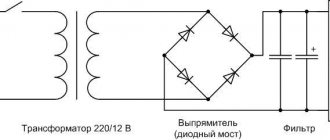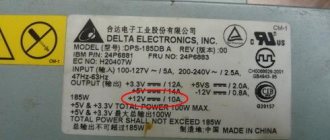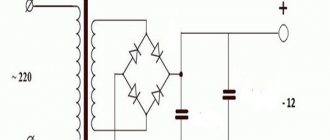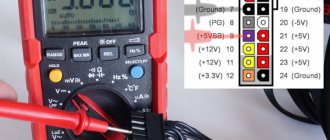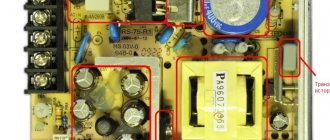We recently talked about the pros, cons, and overall differences between the three types of modern 4K HDR TV panels. These included OLED TVs, LCD/LED TVs, and the newest addition to the TV landscape, QLED TVs. In covering these technologies, we briefly touched on the current state of IPS or VA displays in QLED and 4K LCD TVs. Now we will tell you what these two terms mean and how they can affect your choice in purchasing a 4K TV. It's also worth noting that VA and IPS display technologies have nothing to do with 4K OLED TVs, which is a completely different matter.
How many amperes are in 1 kW 380 V?
But if necessary, you can calculate it, we know the voltage is 220 Volts (or 380, you need to look at the location). There are 1000 Watts in one kilowatt, divide 1000 by 220, we get 4.54545454545, if we round (the exact figure is simply not needed for these calculations), then 4.5 Amperes per 1000 Watts (one kilowatt) .
Interesting materials:
How to send SMS not through IMessage? How to send a video from a gallery to VK? How to send a video via Viber? How to send more than 20 messages in a contact? How to scare away the ruff? How are they released on leave in the army? How to grow nails in 5 minutes? How to mirror an image in Word? How to adjust the burner on a gas stove? How to adjust a tilting plastic window?
The essence of the phenomenon
In a DC circuit, 1 VA is the equivalent of one watt (1 W). Power (P) (in watts) in a DC circuit is equal to the product of voltage (V) in volts and current (I) in amperes: P = VI
Volt-amps
In an AC circuit, power and V•A mean the same thing when there is no reactance. It is introduced when the circuit contains an inductor or capacitor. Since most AC circuits contain reactance, the V•A value is greater than the actual power dissipated or delivered in watts. This can cause confusion regarding power supply specifications.
For example, the power supply may be rated at 600 V•A. This does not mean that it can output 600 watts if the equipment has no reactance. In real life, the P rating of a power supply is 1/2 to 2/3 of the actual V•A.
Important! When purchasing an uninterruptible power supply for use with electronic equipment, including computers, monitors, and other peripherals, you must ensure that the V•A specifications for the equipment are used in determining the minimum ratings for it. The V•A rating is nominally 1.67 times (167%) more watts.
Power
Convert V•A to Watts
To correctly size, for example, a power supply, it is important to understand the difference between watts and volt-amps. Real power, measured in watts, is a portion of the energy flow consumed and is related to the resistance in an electrical circuit. An example of this is the filament in a light bulb.
Volt ampere conversion
Reactive power, measured in VAR or “volt ampere reactive”, is the portion P of stored energy flow. Stored energy is associated with the presence of inductance and capacitance in an electrical circuit. Apparent power, measured in V•A, is a mathematical combination of real and reactive P.
The geometric relationship between apparent, reactive and real power is defined by the triangle P. Mathematically, real power (W) is related to apparent power (V•A) using a numerical relationship called power factor (PF), which is expressed in decimal form and ranges from 0 to 1.0. For many new types of IT equipment, such as computer servers, the PF is 0.9 or higher. For outdated personal computers (PCs), this value can be 0.60 - 0.75.
Since many types of equipment are rated at P in watts, it is important to consider PF when sizing a UPS. If PF is not taken into account, the size of the required UPS can be reduced. For example, a piece of equipment with a power of 525 W and a power factor of 0.7, which must be multiplied by the power, determines the minimum power with a load of 750 V•A.
750 V•A = 525 W / 0.7
If the UPS is rated at 75%, you will get a UPS rated 1000 V•A (750 VA / 0.75 = 1000 V•A).
Electrical conductivity of semiconductors
The electrical conductivity of semiconductors themselves is electronic in nature and strongly depends on impurities. The technical use of this property has found application in the creation of amplifiers and key elements of modern electronics. Characteristic semiconductors are tetravalent germanium (Ge) and silicon (Si), which form a crystalline structure of atoms connected to each other by covalent bonds from electron pairs of the outer shell of the atoms. The introduction of impurities dramatically changes the conductivity of these semiconductors. For example, when adding pentavalent gallium (Ga) or arsenic (As) atoms, an excess of valence electrons is formed in the semiconductor, which become the common property of the semiconductor sample, in this case they speak of n-type conductivity. If trivalent indium (In) is added to a semiconductor, then a deficiency of valence electrons is formed, in this case they speak of “hole” p-type conductivity.
The electrical conductivity of semiconductors strongly depends on the application of external factors, such as an electric or magnetic field, illumination with light of varying intensity and spectrum, or exposure to various types of radiation, including gamma rays. The word "quanta" is not used in English terminology. This property of doped semiconductors has found wide application in modern technologies. The unique property of one-way conductivity is possessed by a combination of semiconductors with different types of conductivity, the so-called pn junction, which has become the basis of modern electronics.
Converting power units by dividing by voltage, converting with a calculator
To select a circuit breaker, use the following formulas:
- direct current (single-phase network 220 V ):
I = P/U,
- three-phase network 380 V :
I = P/ (U * √3).
The data obtained will be useful for selecting wiring, sockets, and other functional components.
Ampere calculator
For your information. On specialized websites you can find a Watt calculator and other programs for automated calculations.
How to use
To convert current into power, it is enough to enter the nominal voltage and indicate the second known value. The calculator will automatically calculate the unknown indicator and display the result.
You can find out the voltage and standard current in the technical documentation of the device. For household appliances, the power is usually indicated, from which the current is also easy to calculate. For convenience, in the calculator you can switch watts to kilowatts, and amperes to milliamps.
Read further:
Calculation of electrical power during repair and design
Kilowatt to horsepower conversion calculator
Car engine power calculator
Calculator for converting pressure in bar to pressure in megapascals, kilograms of force, pound of force and atmospheres
Battery discharge time calculator
Errors when calculating V•A
The ratios of volt amperes and watts for certain types of electrical appliances and devices, for example, light bulbs, are identical. But when talking about computers, watts and V•A will be different, but V•A will always be greater than or equal to watts. The gap is related to power factor (PF), which varies among devices. If you do not take it into account, then when selecting equipment elements an error will be made and they will not fit the main device.
If we consider the choice of a UPS for a personal computer, and on the passport data the rating is indicated in voltamper, this will make it difficult to select a rating in W. When there are no exact indicators of P, do the following - the load data indicated on the nameplate is taken equal to 60% of the V•A indicator of the UPS.
You might be interested in How to calculate reactive and active power
Online calculator
Additional Information. In order to more accurately determine the data, you can use an online calculator. Some websites provide the user with the required P if they click on the device type, such as TV or desktop. These sites often show graphical charts that make it easy to measure the V•A of various appliances, from refrigerators to computers.
It can be concluded that V•A is an important characteristic for modern electrical devices and equipment. If this indicator is not taken into account when purchasing electrical devices, they will operate in overload mode, which will lead to their premature failure.
Object of measurement
To determine volt-amperes (V•A), you will need to perform the following measurements:
- First you will need to measure the current in amperes (A). This is the SI unit of I.
- Next, the voltage should be measured in SI units - volts. It will show the force required for the flow of electric current in volts (V).
- Calculate P - the amount of energy produced by current and volts together. Multiplying amperes (A) by volts (V) gives the resultant or energy.
You might be interested in this: Do-it-yourself diagram and description of the capacitor welding process
Measuring quantities
Direct current (—), or DC, is inherent in the process when it flows in one direction, for example, a flashlight with a battery uses a constant indicator. Alternating current (~) or AC refers to processes with alternating direction of electron movement, due to which it periodically changes its direction. In North America and Western Japan this occurs 60 times per second at a frequency of 60 Hz. In Russia, the EU, most of Australia, South America, Africa and Asia, the frequency is 50 Hz.
Watt's law formula
To convert these quantities, the formula of Watt's law is used:
Power (P) = Current (I) x Voltage (V), the same in units: watt = ampere x volt. To find amplifiers, use the Watt formula in reverse and divide the power by the voltage: Current (I) = Power (P) ÷ Voltage (V) I = 600 W : 120 V, then the value of I = 5A
Note! When specialists operate with large dimensions P, they use kilowatts (kW), 1 kW = 1000 W.
General information
If the term “electrical conductivity” is familiar mainly to specialists in physics and electrical engineering, then almost everyone has heard about superconductors, through the efforts of journalists. Along with the development of thermonuclear energy, the creation of superconducting materials that operate at normal terrestrial temperatures is the dream and philosophy stone of 21st century physics.
The technical implementation of this task will allow humanity not to pay an exorbitant tribute for the use of the most convenient type of energy - in the form of heat losses during the generation, transformation and transmission of electricity. The indirect effect of the development of superconductivity would be a significant improvement in the ecology of the environment due to a decrease in the level of emissions of harmful combustion products of coal, fuel oil and gas from thermal power plants, and an end to the useless heating of the Earth’s atmosphere, and a reduction in greenhouse gas emissions.
In addition, the introduction of superconductors in various sectors of industry and transport would lead to a new technical revolution, the fruits of which could be enjoyed by the entire population of the Earth. All electrical machines - generators, transformers, engines - would decrease in size, but their power would increase; the use of electromagnets based on superconductivity would significantly bring the solution to the problem of thermonuclear fusion closer, and high-speed trains would become a reality.
Based on this, the interest in the problem of superconductivity on the part of scientists and engineers around the world is understandable, and the first materials capable of realizing practical superconductivity are already appearing. The main direction of research efforts has recently become graphene and graphene-like materials, which are essentially two-dimensional structures with unique conductivity.
Ernst Werner von Siemens
Results of comparison between IPS and VA
Of course, it can be argued that neither type of IPS or VA panel is inherently superior to the other. Although there is some validity to this statement due to the fact that both have an area where one panel is much more advanced than the other.
Still, it's clear that VA is the best choice for most people who don't need wide viewing angles in their living room or office.
Assuming you don't need to view your 4K TV far from the center axis of the screen, a VA display easily delivers better performance in three of the most important areas: black level, contrast, and black uniformity. It is also possible to consider PLS and IPS differences. Matrix VA or IPS2017-04-12T23:23:21+03:00 SemenVideoVideoWe recently talked about the pros, cons and differences in general between the three types of modern 4K HDR TV panels. These included OLED TVs, LCD/LED TVs, and the newest addition to the TV landscape, QLED TVs. While covering these technologies, we briefly touched on the current state of IPS or VA displays in QLED TVs and...SemenSemen EditorUltraHD
Electrical conductivity of metals
Copper has high electrical conductivity, equal to 56 MS/m at 20°C
Long before the discovery of electrons, it was experimentally shown that the passage of current in metals is not associated, unlike the current in liquid electrolytes, with the transfer of matter. An experiment, elegant in its simplicity, performed by the German physicist Carl Viktor Eduard Riecke in 1901, convincingly proved that current carriers in metals are a certain substance, unknown at that time. For a year, he passed an electric current through a kind of “sandwich” of dissimilar metals (copper-aluminum-copper) and, at the end of the experiment, discovered that the metals did not mix. Later, through the works of the Danish scientist Niels Bohr, a theory of the planetary structure of the atom was created and brilliantly confirmed, consisting of a positive nucleus, which includes particles that we now call nucleons - these are protons and neutrons - and outer shells of negatively charged electrons. Physicists still use this theory, although they have made some adjustments to it.
The conductivity of metals is due to the presence of a large number of valence electrons from the outer shells of metal atoms, which do not belong to a specific atom, but become the property of the entire ensemble of atoms of the sample. It is quite natural that metal atoms that have a larger number of electrons in their outer shell also have higher electrical conductivity - this includes copper (Cu), silver (Ag) and gold (Au), which has always distinguished the value of these metals for electrical engineering and electronics.
Due to the properties of electrical conductivity, semiconductors are widely used to create amplification and key elements of modern electronics.
IPS or VA
VA or IPS, which is better is a matter of preference for the two types of LCD TV panel technologies that completely dominate the current 4K LED TV market. All LCD TVs sold by major domestic and foreign brands that you will find at any retailer are built using IPS or VA technology.
This also applies to today's QLED TVs from Samsung, because despite the marketing lingo and a few color enhancements, QLED is still a backlit LCD/LED TV (at least for now). Obviously, VA or IPS panel types occupy a large niche in the market, and therefore knowing what is behind each technology will affect which 4K TV you buy, because VA and IPS have their own pros and cons when compared.
Electrical conductivity of gases
The electrical conductivity of gases is due to the presence of free electrons and ions in them, and therefore is called electron-ionic conductivity. Gases, due to their rarefaction, are characterized by a long path length before the collision of molecules and ions; because of this, their electrical conductivity under normal conditions is low. The same can be said for mixtures of gases. A natural mixture of gases is atmospheric air, which in electrical engineering is considered a good insulator. The electrical conductivity of gases greatly depends on various physical factors, such as pressure, temperature, and mixture composition. In addition, various types of ionizing radiation have an effect. Thus, for example, when illuminated by ultraviolet or x-rays, or under the influence of particles emitted by radioactive substances, or, finally, under the influence of high temperature, gases acquire the property of conducting electric current.
At high voltage, air ionizes and becomes a conductor
This process is called ionization. photochemical ionization predominates in the upper layers of the Earth’s atmosphere
due to the capture of a photon of ultraviolet radiation or an X-ray quantum by a neutral molecule, with the emission of a negative electron and the transformation of the molecule into a positively charged ion.
In turn, a free electron, joining a neutral molecule, turns it into a negatively charged ion. In the lower layers of the atmosphere, impact ionization
due to the collision of gas molecules with corpuscular particles of solar and cosmic radiation.
It should be noted that the number of positive and negative ions in atmospheric air under normal conditions is very small compared to the total number of its molecules. 1 cubic centimeter of gas under normal conditions of pressure and temperature contains about 30 * 10¹⁸ molecules. At the same time, in the same volume the number of ions of both types is on average 800–1000. This number of ions varies in full accordance with the time of year and time of day, depends on geological, topographic and meteorological conditions and on the weather: for example, in summer the number of ions is much greater than in winter, in clear and dry weather more than in rainy and cloudy; with fog, the ionization of the surface atmosphere is reduced to almost zero.
What is voltage, Volt [V]
How to calculate amperes
By creating a potential difference, they ensure the movement of charges. The unit of measurement is one Volt. This voltage ensures the movement of 1 Coulomb (C) of electric charge between the poles. During this process, work with energy of 1 Joule (J) is performed.
The same value (V) can be represented as the potential difference to release a unit power of 1 W (W) when the current is limited to one ampere. Similarly, it is permissible to use proportions when determining the relationship between voltage and electrical resistance (R). The listed dependencies can be expressed as follows:
V=J/C=W/A=A*R.
The simplest formulas are valid for calculating a DC network. If sinusoidal oscillations are considered, in addition to the amplitude, it is necessary to take into account the corresponding changes in voltage depending on time. The instantaneous value is described as follows:
Ut=Ua*sin(w*t+ϕ),
Where:
- Ua – maximum voltage deviation (amplitude);
- w – frequency;
- t – time;
- ϕ – phase (initial).
For simplified calculations, it is convenient to use the root mean square voltage ( Uc p), which is related to the amplitude value by the following proportion:
Ucр=Ua*(1/√2)≈ Ua*0.707.



